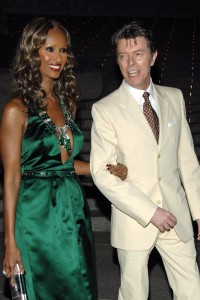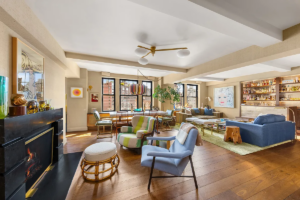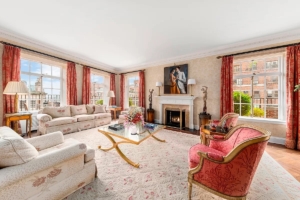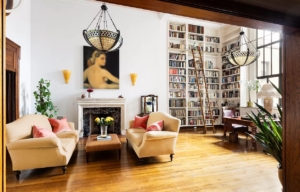David Bowie left a big farewell gift with the release of his final video “Lazarus,’’ off his final album, Blackstar. The transformative rock star passed away Sunday in London after battling cancer, but he left behind a haunting, but affirming message that he’s free as a bluebird. Gaunt, but ever original and dynamic, Bowie wanted us to all see his rise to heaven.

David Bowie with wife, Iman, attending the Tribeca Film Festival after-party, 2007.
With his passing, the world lost a genius whose work didn’t just influence the entire arc of where rock music and performance art intersect, but changed pop culture. Ziggy Stardust shared a January 8 birthday with Elvis Presley and, if Elvis was the King, Bowie was the Androgynous King who flung the door open on gender and identity-bending expression.
No wonder, then, that in his adopted home of New York City, Bowie’s life and death sent neighbors near his penthouse at 285 Lafayette Street flinging open their windows to allow strains of Bowie’s music fill the cold, morning air. His final breath might have been in his native London, but New York was Bowie’s beloved adopted home for decades. It was the city he said he dreamed of in his youth, and it was in SoHo where Bowie’s real-life transformation from international rock star to stay-at-home husband and dad played out.
Bowie was the artist who opened The Concert for New York City in Oct. 2001, a benefit for NYFD, NYPD and first responders to the 9/11 terrorist attacks on the World Trade Center. He sang Paul Simon’s “America” and his own “Heroes” — a song that became an anthem for the heroic rescuers.
The floral tribute to David Bowie outside his Soho apartment pic.twitter.com/iZIHJwV6Rv
— Laura Trevelyan (@LauraTrevelyan) January 11, 2016
Bowie, whose real name was David Jones, purchased a pair of penthouses at 285 Lafayette when it underwent condo conversion in 1999. He had lived there ever since along with his wife, former supermodel Iman, and their teenaged daughter, Alexandria. It was here where Bowie could walk the streets without being hassled, especially since suffering what was called a heart attack in 2004. Over the past decade, Bowie lived far more like David Jones, admitting that he had become more like his father than Ziggy Stardust as he aged.
While he was frequently seen walking the streets of SoHo or eating in his local favorites, like Caffe Falai near his home, Bowie had grown increasingly reclusive. In 2001, when Bowie went to Woodstock to record in the mountaintop recording studio called Allaire, he fell in love with the nearby hamlet of Shokan.
“It was almost an epiphany that I had,” Bowie told Interview in June 2002. “Walking through the door, everything that my album should be about was galvanized for me into one focal point…I knew what the lyrics were already. They were all suddenly accumulated in my mind.”
He and Iman bought 64 acres in the Catskills in 2003 along Little Tonche Mountain and completed his house in 2012. Bowie hated Woodstock, calling it “too cute,” but came to prize the “gravitas” the mountains gave him in writing some of his last songs.
If New York City called to him in his youth, then upstate New York was his creative inspiration later in his career.
So, the world was lucky that David Jones turned into David Bowie who created Ziggy Stardust. But us New Yorkers felt especially blessed to have this artistic icon walk among us. Rest in peace, neighbor.









